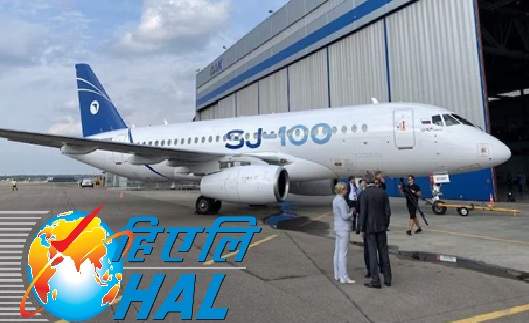
- Collaboration is expected to significantly reduce India’s dependence on American and European civilian aircraft manufacturers such as Boeing and Airbus.
- By manufacturing the Sukhoi Superjet (SJ-100) domestically, India stands to benefit from low-cost production, greater accessibility, and enhanced self-reliance in aviation technology.
- This agreement also comes at a strategically significant time, just one month ahead of President Vladimir Putin’s scheduled visit to India.
In a watershed moment for India’s defence manufacturing aspirations, the state-owned Hindustan Aeronautics Limited (HAL) has reached an understanding with Russia’s United Aircraft Corporation for the development of the Sukhoi Superjet (SJ-100), a twin-engine short-haul regional aircraft. The agreement was signed in Moscow and marks India’s first full-scale civilian aircraft manufacturing collaboration in decades.
Under this deal, India has been granted the rights to assemble the Sukhoi Superjet (SJ-100) domestically. The assembly operations will take place in India, signifying a major boost to India’s defence manufacturing ecosystem, the UDAN scheme, and the broader Make in India initiative.
This collaboration is expected to significantly reduce India’s heavy dependence on American and European civilian aircraft manufacturers such as Boeing and Airbus, which currently dominate nearly 90 per cent of the global civilian aircraft market. The last time India produced a civilian aircraft was the Avro HS 748 project, which began in 1961 and concluded in 1988.
The Sukhoi Superjet (SJ-100) has already seen over 200 units produced and is operated by 16 airlines worldwide. Typically, the SJ-100 can carry around 103 passengers and has a range of approximately 3,500 kilometres. It is an all-weather aircraft, capable of operating efficiently in diverse climatic conditions ranging from minus 55 degrees Celsius to 45 degrees Celsius. One of its key advantages is its low operating cost, making it an ideal choice for a country like India, which aims to strengthen regional air connectivity under the UDAN scheme.
By manufacturing the Sukhoi Superjet (SJ-100) domestically, India stands to benefit from low-cost production, greater accessibility, and enhanced self-reliance in aviation technology.
This agreement also comes at a strategically significant time, just one month ahead of President Vladimir Putin’s scheduled visit to India. It reflects the intent of both nations to diversify their partnership beyond defence into economic and industrial cooperation. Moreover, this development coincides with growing external pressure on India from the United States, prompting New Delhi to further consolidate ties with trusted partners like Russia while maintaining strategic autonomy.
The timing of this agreement is also notable, given recent reports of technical malfunctions and reliability concerns involving certain American and European aircraft models. This situation creates an opportunity for the Sukhoi Superjet (SJ-100) to expand its market presence while offering India a chance to advance its domestic manufacturing ambitions and fill an important gap in the global civil aviation sector.
Aayush Pal is a freelance writer on contemporary geopolitical developments. The views expressed in his work are entirely his own.
